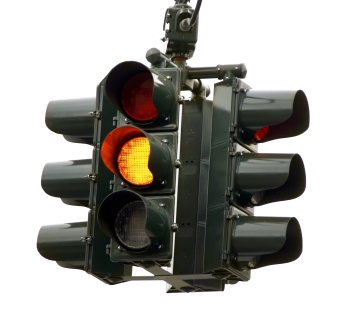Longer yellow lights could save lives
Kathryn Hawkins
When you approach an intersection and the traffic light has turned yellow, you have a tiny window of time to make a decision: Do you speed up and rush through before the light turns red, or do you stop your car?
Choose incorrectly, and that decision could cost you. The National Highway Traffic Safety Administration found that more than 2.5 million U.S. car crashes were caused by driver behavior at traffic signals in 2010. Nearly 4,500 of those resulted in at least one death.
Even if no one is injured or killed in a traffic-light accident, you may suffer when it comes to your car insurance.
“Each case is reviewed and decided on its own merits, and no two accidents can be rated the same,” says Arlene Lester, a spokeswoman for State Farm. In states that have a “comparative negligence” law, she says, both drivers involved in a two-car accident can share in the fault of the accident.
If you’re found to be fully or partially at fault, you may not be covered for the accident, depending on whether you’ve paid for collision coverage (which provides coverage for damage resulting from a collision) and whether the other driver’s insurance company is obligated to pay for your repairs. Even if you weren’t at fault, your insurance rates still may go up by as much as 40 percent.
But a new study by Hesham Rakha, director of the Center for Sustainable Mobility at the Virginia Tech Transportation Institute, has found a simple way to reduce the incidence of car crashes at traffic lights: extend the length of the yellow-light interval.
Yellow lights and the “dilemma zone”
On average, a yellow light interval lasts 4.2 seconds for a road with a speed limit of 45 miles per hour; for roads with higher speed limits, the time span is slightly longer. However, that varies from place to place; no national standards are in place for yellow-light duration.
The American Motorists Association, an advocacy group for motorists’ rights, recommends an absolute minimum of three seconds regardless of speed limit, but for a road with a 45 mph limit, it recommends an interval of five seconds. These intervals are based on a formula from the Institute of Transportation Engineers.
“The faster traffic is moving, the longer the yellow light needs to be,” says John Bowman, a spokesman for the American Motorists Association, an advocacy group for drivers. “This is because vehicles that are traveling faster require more time and distance to stop.”

Rakha found in the study that not all people have the same reaction times. People who are over age 60, for instance, often need more time to stop. Another issue is that many people drive faster than the posted speed limits and need extra time to slow down.
If the yellow-light interval is too short, drivers enter what Rakha calls a “dilemma zone,” where there’s not enough time to slow down before reaching the intersection, yet the light turns red before the car has passed through. This happens frequently: The study found that 43 percent of drivers who zipped through an intersection while the light was yellow weren’t able to complete the trip before the light turned red.
Changing the length of yellow lights
In cities with red-light cameras, Bowman says, some city officials have deliberately reduced yellow-light interval timing in an effort to bump up the number of fines they can collect from drivers who run red lights. Shortening the yellow-light intervals actually can increase the number of car wrecks – the opposite effect of the cameras’ intended purpose.
On the flip side, when cities extend their yellow-light intervals, accident rates go down substantially at intersections. In the Southern California city of Loma Linda, officials lengthened yellow-light intervals, which resulted in traffic accidents plummeting by 92 percent. A Texas Transportation Institute study showed that increasing yellow-light times by just one second led to a 40 percent drop in crashes.
“Clearly, a simple thing like lengthening yellow-light timing can have a huge positive impact on traffic safety,” Bowman says. “Yet the cities that use red-light cameras have become so dependent on the income from the cameras that they rarely consider it.”
Avoiding the dilemma zone
In addition to the simple solution of extending yellow-light intervals in areas where they’re below recommended guidelines, Rakha’s team has several other suggestions for preventing wrecks at traffic lights.
The team recommends adding a series of caution lights that can alert drivers when the light is about to change from green to yellow, giving them additional time to slow down.
Researchers are looking into the prospect of a sophisticated in-car system, which can be customized to give drivers enough of a warning to can stop in time.
“So, one person receives a four-second warning of a light change, and another person receives a five-second warning. Or, instead of a warning, the system might just tell you to stop,” Rakha says in a statement.
